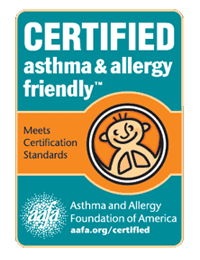Before you start a home building or renovation project, consider how the products you use or install may impact the overall health of your home. Construction can produce a lot of dust and volatile organic compounds (VOCs). Studies have found a connection between asthma episodes in children and exposure to home renovations (such as new interior paint).1
It’s important to consider choosing materials that release fewer gases or other asthma triggers. While doing renovations, use personal protective equipment, such as N95 masks and gloves. Also, make plans for family members with asthma (especially children, pregnant people, and older adults) not to be in the house during renovation projects.
 Paint
Paint
It is not possible to make paint without using chemicals. So what is it that makes some paints better for the indoor environment than others? And what does it mean if a paint is CERTIFIED asthma & allergy friendly®? We identify paints that do not have ingredients that are unnecessarily harmful. We look at three things when we test paints:
- We paint a sample surface and measure all the VOCs released over 14 days to make sure levels remain low. We look in particular at VOC levels in the first 24 hours, when they are highest.
- How well does the paint perform? Paints should stick to the wall properly, dry in a reasonable time, and hold up to scrubbing to clean a reasonable level of stain from them.
- What are the chemical components of the paint? How much of these chemicals are in the paint? Are any of the chemicals known to irritate skin and/or eyes? If yes, are they present at a level low enough that they are unlikely to cause problems?
 Flooring
Flooring
Some types of flooring can release VOCs when installed, especially if they are installed with an adhesive. And it is easier for allergens to get trapped in some types of flooring. Our Certification Program tests and certifies luxury vinyl plank (LVP) flooring, sheet vinyl flooring, vinyl tile, linoleum, sports flooring, and textile flooring.
For flooring to be CERTIFIED asthma & allergy friendly®, it must pass the following tests in an environmentally controlled chamber:
- We measure the VOCs released for 14 days after the flooring is installed. If the flooring is designed to be used with an adhesive, we include the adhesive in the test so we accurately recreate the installation experience. We look in particular at VOC levels in the first 24 hours, when they are highest.
- For hard surface flooring, we introduce allergen-containing test dust into the chamber, allow it to settle, and then clean it. We want to make sure the allergen can be removed and make sure allergen levels in the air do not increase significantly during cleaning.
- For textile flooring, we embed allergen-containing test dust into the flooring using a roller, then clean it using a vacuum cleaner. We want to make sure that the allergen can be removed and make sure that allergen levels in the air do not increase substantially during cleaning.
 Insulation
Insulation
Fiberglass insulation may release VOCs during and after installation. It can impact people with sensitive airways. Fibers, airborne particles, and dust can be released during and after installation. And some insulation can support mold growth.
In order for fiberglass insulation to be CERTIFIED asthma & allergy friendly®, it must undergo the following tests:
- During installation in an environmentally controlled chamber, we measure the amount of dust and small fibers that are released into the air. We agitate the dust and fibers during this test to mimic a person walking around near the insulation. We set strict limits on what is produced.
- We measure all of the VOCs released from the insulation over 14 days to make sure levels remain low. We look in particular at VOC levels in the first 24 hours, when they are highest.
- We place mold spores on pieces of insulation and keep them at a high temperature and humidity for four weeks to see if the mold spreads.
- We do a detailed assessment of all the materials used to make the insulation and what concentration is present.
Are There Paints, Flooring, and Insulation That Are Definitely Safe?
Unfortunately, no. People can be sensitive or allergic to many different substances and can have different reactions. It is not possible to say a product will not cause symptoms for anyone. But you can make healthier choices when building or remodeling your home. Our Certification Program aims to help you create a healthier indoor environment by reducing your exposure to asthma and allergy triggers.

Visit aafa.org/certified to search for CERTIFIED products. There you can also learn more about the asthma & allergy friendly® Certification Program.
References
1. Tiotiu, A. I., Novakova, P., Nedeva, D., Chong-Neto, H. J., Novakova, S., Steiropoulos, P., & Kowal, K. (2020). Impact of Air Pollution on Asthma Outcomes. International journal of environmental research and public health, 17(17), 6212. https://doi.org/10.3390/ijerph17176212
2. Volatile Organic Compounds' Impact on Indoor Air Quality. (2022, August 26. Retrieved April 4, 2023, from https://www.epa.gov/indoor-air...t-indoor-air-quality
3. Saif, N. T., Janecki, J. M., Wanner, A., Colin, A. A., & Kumar, N. (2021). Pediatric Asthma Attack and Home Paint Exposure. International journal of environmental research and public health 18(8), 4118. https://doi.org/10.3390/ijerph18084118

Comments (0)